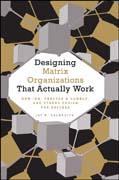
Designing matrix organizations that actually work: how IBM, Proctor & Gamble and others design for success
Galbraith, Jay R.
Based on 40 years of experience as an academic and consultant in organizationdesign, expert Jay Galbraith explains what a matrix organization is, why you would choose to implement the matrix structure, and how to implement the matrix design successfully. The introduction explains "What is a Matrix?" and "Why would anyone choose one?" and concludes with the Star Model which provides fora complete design of the matrix organization. Written for consultants, internal HR and managers, executives, and executive education courses in organizational design and?management. INDICE: Preface. Introduction: Matrix Organizations: What Are They? Where Did They Come From? What Is a Matrix? What Are the Origins of the Matrix? WhatHappened? The Star Model. Implications of the Star Model. PART ONE: SIMPLE MATRIX ORGANIZATIONS. 1. Simple Matrix Structures. Two-Dimensional Structures. Pharmaceutical R&D Lab Example. Summary. 2. The Two-Hat Model. What Is the Two-Hat Model? Examples of Two-Hat Structures. Summary. 3. The Baton Pass Model. The Consumer Goods Model. The Pharmaceutical Model. Summary. 4. The Matrix Within a Matrix. Design Challenges of the Matrix Within a Matrix. Matrix Within a Matrix at the Corporate Level. Mars Pet Food Example. Summary. 5. Balancing Power and Defining Roles. Designing Power Bases. Roles and Responsibilities. Summary. PART TWO: COMPLEX MATRIX STRUCTURES. 6. The Three-Dimensional Matrix. International Strategy. The Geography-Dominant Matrix. The Balanced Matrix. The Business-Dominant Matrix. Differentiated Structures. Other Three-Dimensional Models. Summary. 7. More Complex Matrix Structures. Global Account Teams. The Front-Back Hybrid Model. Summary. 8. The IBM Structure. The IBM Front-Back Hybrid. More Complexity? Summary. PART THREE: COMPLETING THE STAR MODEL. 9. Communication in the Matrix. Informal Communication. Formal Communication. Summary. 10. Planning and Coordination Processes. Goal Alignment, Dispute Resolution, and Coordination Mechanisms. Summary. 11. Planning Processes in the Complex Matrix. What About Complex Matrix Designs? Get the System in a Room. Online Processes. Summary. 12. Human Resources Policies. Human Capital. Social Capital. Summary. 13. Leadership in a Matrix Organization. Seeing That Conflicts Are Resolved. Managing the Top Team. Balancing Power. Summary. 14. Implementing a Matrix. Using the Star Model. Building Capabilities. Summary. 15. A Synopsis of Matrix Capabilities. Epilogue: Personal Stories: The Use and Abuse of the Matrix. Early Phase: "What Is a Matrix, Anyway"? Matrix Takes Off and Becomes Trendy. The Phase of Decline. The Stealth Matrix Phase. Today: Matrix out of the Closet. References. About the Author. Index.
- ISBN: 978-0-470-31631-3
- Editorial: John Wiley & Sons
- Encuadernacion: Cartoné
- Páginas: 272
- Fecha Publicación: 19/11/2008
- Nº Volúmenes: 1
- Idioma: Inglés
